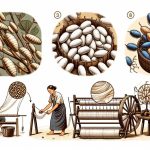I found that cotton thrives in warm regions like the United States, India, China, and Brazil. These countries have ideal conditions for growing cotton, making them important in the global cotton market. Other significant cotton-producing nations include Uzbekistan, Turkey, Australia, and Egypt. Regions with well-drained soil, ample sunlight, and water support cotton growth. Places like the Indus Valley, Nile Delta, and California's Central Valley are prime cotton farming areas. Historical practices, technological advancements, and market demand influence the global distribution of cotton. Learn more about cotton's worldwide presence and cultivation patterns in various regions.
Table of Contents
Key Takeaways
- Cotton is found in warm climates like the Southern United States, Central Asia, Africa, and parts of South America.
- Major cotton producers include the United States, China, India, and Brazil.
- Ideal regions for cotton cultivation have well-drained soil, abundant sunlight, and ample water.
- Notable cotton-producing nations also include Uzbekistan, Turkey, Australia, and Egypt.
- Historical practices, technological advancements, and market demand influence global cotton distribution.
Global Distribution of Cotton
Cotton thrives in regions with warm climates, such as the Southern United States, Central Asia, Africa, and parts of South America. The global distribution of cotton is significant, with major producers including the United States, China, India, and Brazil. The United States stands out as the top cotton exporter globally, with states like Texas, California, and Mississippi leading in production. The Southern U.S. provides ideal climate conditions for cotton cultivation, with well-drained soil, sunlight, and moderate rainfall being essential factors.
Agricultural practices in these regions have evolved with technological advancements, enhancing productivity and sustainability. Factors like climate conditions play a crucial role in determining the success of cotton crops worldwide. Understanding the interplay between agricultural practices, climate conditions, and technological innovations is key to ensuring a stable global cotton supply. The United States, China, India, and Brazil continue to drive the global cotton market, showcasing the importance of strategic agricultural development in meeting the demand for this versatile crop.
Cotton Growing Regions Worldwide
Amidst the diverse landscapes and climates across the globe, regions with warm temperatures and suitable growing conditions stand out as prime locations for cotton cultivation. The United States, China, India, Brazil, and Pakistan are major players in the global cotton market, each with its own unique cultivation practices and regional specialization.
In the U.S., states like Texas, California, Mississippi, Missouri, and Arizona are key producers of cotton, with California leading in Pima cotton production and Texas dominating Upland cotton cultivation. These regions showcase specialized approaches to cotton farming, emphasizing the importance of tailored practices for best yields.
The U.S. stands out as a significant contributor to global cotton production, with bales weighing around 500 pounds, highlighting the substantial output from these major growing regions. Factors such as land management, genetic advancements, mechanization, and irrigation techniques play pivotal roles in the success of cotton cultivation in these key regions.
Major Cotton Producing Countries
Among the diverse landscapes and climates worldwide, it's noteworthy to emphasize the top countries leading in global cotton production. The United States, India, China, Brazil, and Pakistan stand out as major players in the cotton industry.
India holds the top position as the largest cotton producer globally, closely followed by China and the United States. Brazil and Pakistan also play a substantial role in the global cotton supply chain. These countries play essential roles in meeting the demand for the textile industry. Their production levels influence international market dynamics and trade relationships within the cotton industry.
The strategic importance of these nations in cotton production reflects their impact on the global supply chain and the interconnectedness of the textile industry. Understanding the dynamics of cotton production in these key countries is essential for comprehending the complexities of the international cotton market and the trade relationships that drive it.
Cotton Cultivation Locations
Warm, tropical and subtropical regions worldwide host primary cotton cultivation locations. Countries such as the United States, India, China, Brazil, and Pakistan are major contributors to global cotton production. In the United States, states like Texas, California, Mississippi, and Missouri are significant cotton cultivation areas. These regions provide the necessary conditions for cotton growth, including adequate sunlight, moderate rainfall, and a long frost-free period.
Successful cotton cultivation in these locations is also supported by proper irrigation practices to make certain the crops receive sufficient water for healthy development. The fertile soils in these regions further aid in producing high-quality cotton. Overall, cotton thrives in warm climates with access to water and suitable soil conditions, making the mentioned regions ideal for cultivating this valuable crop.
Where in the World Is Cotton Grown?
In exploring the global production of cotton, it's essential to understand the diverse regions where this valuable crop flourishes. Cotton thrives in warm climates, making countries like the United States, India, China, and Brazil significant producers. The United States stands out as one of the largest cotton producers worldwide, with states such as Texas, California, Mississippi, and Missouri leading in cotton cultivation.
Other notable cotton-producing nations include Uzbekistan, Turkey, Australia, and Egypt. Ideal regions for cotton cultivation have well-drained soil, abundant sunlight, and ample water, making areas like the Indus Valley, Nile Delta, and California's Central Valley prime locations for cotton farming.
The global distribution of cotton production is influenced by historical cultivation practices, technological advancements, and market demand for cotton products, shaping the landscape of cotton cultivation across the world.
Frequently Asked Questions
Where Is Cotton Most Commonly Found?
Cotton grows abundantly in warm, tropical regions worldwide. Major producers include the United States, India, China, Brazil, and Uzbekistan. Ideal conditions for cotton cultivation involve ample sunshine, moderate rainfall, and a frost-free period.
Where Does Cotton Originally Come From?
Originally, cotton comes from the Americas, with its domestication in Peru around 4200 BC. The Indus Valley civilization in present-day Pakistan also cultivated cotton around 3000 BC. Columbus found cotton in the Bahama Islands in 1492.
Where Can Cotton Grow in the Us?
I'll share where cotton grows in the US. States like Texas, California, Mississippi, and Arizona are key. Texas leads in production, with over 6 million acres dedicated to cotton. California stands out for Pima cotton.
Was Cotton Found in America?
Yes, cotton was found in America. It became an essential crop with significant economic impact. Colonists began growing cotton in 1616. Eli Whitney's cotton gin in 1793 revolutionized production. By 10 years, its value soared from $150,000 to over $8 million.
- Aramid Laminate Fabric Rolls: Benefits and Applications - June 23, 2025
- Aramid II Fabric: What’s New and Improved? - June 22, 2025
- Exploring Glass-Aramid Fiber Hybrid Fabrics - June 22, 2025






